I have been wondering why people do not use all these new powerful low voltage, high current high transconductance devices IR has released the last 10 years or so.
Why do people keep on using old (and according to me substandard) IRFP240/250 etc when there is so much potential improvement available in using devices with lower voltage ratings - more suitable for the low voltages we use in our simple class A amps?
I made a simple test-amp in LTSpice and tested a few different devices under the same circumstances - the same voltages and the same amount of current through the device etc.
http://www.firstwatt.com/pdf/art_zen_redux.pdf
This is the article Nelson Pass published many years ago, which got me playing with "strange" devices like the IRLB3813 and IRF3706 from the beginning.
http://www.irf.com/product-info/datasheets/data/irfp240.pdf
http://www.irf.com/product-info/datasheets/data/irfp250.pdf
http://ixapps.ixys.com/DataSheet/DS100218%28IXTH-TT500N04T2%29.pdf
http://www.irf.com/product-info/datasheets/data/irfh6200pbf.pdf
These are the relevant data-sheets for this simulated test.
Take note of the order they come in. There is a (very obvious) reason for this..
I know the IRFH6200 is not suitable for a class A amp, since the PQFN 5X6 package is very difficult to cool. I use this device as an example of the low voltage, high current, high transconductance parts with a slight triode-ish character because it is reasonable similar to the IRLB3813, IRF3711 and several others, and it is in the standard library in LTSpice.
More in the next post.
Cheers,
Johannes
Why do people keep on using old (and according to me substandard) IRFP240/250 etc when there is so much potential improvement available in using devices with lower voltage ratings - more suitable for the low voltages we use in our simple class A amps?
I made a simple test-amp in LTSpice and tested a few different devices under the same circumstances - the same voltages and the same amount of current through the device etc.
http://www.firstwatt.com/pdf/art_zen_redux.pdf
This is the article Nelson Pass published many years ago, which got me playing with "strange" devices like the IRLB3813 and IRF3706 from the beginning.
http://www.irf.com/product-info/datasheets/data/irfp240.pdf
http://www.irf.com/product-info/datasheets/data/irfp250.pdf
http://ixapps.ixys.com/DataSheet/DS100218%28IXTH-TT500N04T2%29.pdf
http://www.irf.com/product-info/datasheets/data/irfh6200pbf.pdf
These are the relevant data-sheets for this simulated test.
Take note of the order they come in. There is a (very obvious) reason for this..
I know the IRFH6200 is not suitable for a class A amp, since the PQFN 5X6 package is very difficult to cool. I use this device as an example of the low voltage, high current, high transconductance parts with a slight triode-ish character because it is reasonable similar to the IRLB3813, IRF3711 and several others, and it is in the standard library in LTSpice.
More in the next post.
Cheers,
Johannes
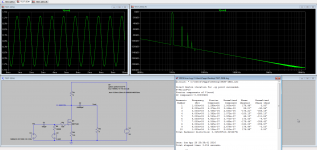
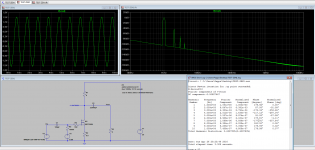
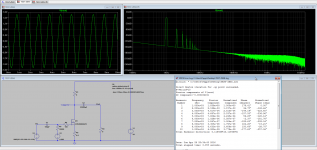
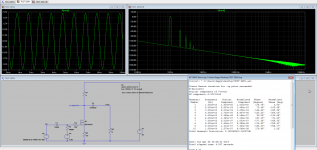
Here is the simple test amp and the comparison of 4 different devices.
Please notice the increase in voltage swing and the decrease in distortion. I would argue that the IRFH6200 is a clear winner, even though the IXYS device has less total THD but with slightly less gain then the IRFH6200. I have no idea how well this simple test match real life results, but considering Nelson Pass article Zen Redux I believe the general trend of the test is reasonably correct.
Even though the IRFH6200 has quite strange transfer curves, it comes out ahead in both low distortion and high gain.
It is also very interesting to observe the distribution of the harmonic content between the different devices.
Based on these tests I would not use IRFP240, but this is my personal conclusion. I don't want to argue agains IRFP240 since they can obviously sound great in class A amps. I just want to encourage people to wander of the reservation a bit and test some new exciting devices.
IRLB3813 can sound great, even if it is a strange little creature. It is important to consider the voltage rating and never exceed it, since this will let the magic smoke out of the device. I have run an IRLB3813 at 25 volts DC Vds without problem, but I don't recommend more then 15 volts DC Vds for this particular device.
Anyone else have any experience with these new and interesting devices?
Cheers,
Johannes
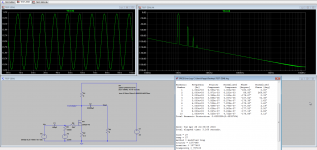
Here is a nice Lateral device intended for audio.
Notice the large drop in gain. You get roughly half the voltage swing from this device compared to the IRFH6200, and despite much lower output you get a large increase in distortion. This might be due to the Spice model of the mosfet, but the simulated results confirm my own experience.
Once again. I don't intend to pick on any one device. I just want to illuminate the potential improvements in distortion available with new low voltage, high current and high transconductance devices.
Very good work! And very interesting conclusions, att lot of important information for future and for hopfully right components in future designs.
When you compare dissimilar devices you have to determine what you want to learn from the comparison. I kept everything except the gain-devices and the bias voltage the same. The different output voltages reflects the different amount of gain you will get from the devices. The IRFPH6200 gives both the best balance between second harmonic and higher order harmonics distortion components, most gain and second least distortion from a fixed input signal level.I could normalize the output level, but this will somewhat conceal the different amounts of gain the device will provide in a simple amplifier circuit.
You should not focus to much on absolute numbers. Look at the general trend. The big picture. The IRFH6200 has less distortion at a higher output voltage then the IRFP240 - with the same input voltage. Every device is run from a 100 ohm source resistance (the 100 ohm gate-stopper) to normalize the operating conditions.
If I where to build a standard Zen amp or PLH amp today, I would probably use the IRFP7430 mosfets, and keep the voltage from the power supply below 40 volts. I guess and believe that I could run the devices at 20 volts Vds from a single 40,0 volt power supply without any problem - as long as I don't run the amp constantly into heavy clipping as a guitar amp or in a pro sound environment. With a 35 volt power supply I could probably run the amp into heavy clipping with very reactive loads indefinitely without destroying the mosfets.
The ACA is a great amp to test out these low voltage devices in. An IRF3711 has a total thermal resistance of 1,54 C/W and could probably be run at 19 watt heat dissipation without any problem. That is 2 ampere through and 9,5 volts over each device. 19 x 1,54 + 25 = 54,26 degrees Celsius (with an adequate heatsink). Better clam down the device with some kind of solid aluminum bar and some 5 mm bolts. Use alu-oxide thermal pads.
Cheers,
Johannes
You should not focus to much on absolute numbers. Look at the general trend. The big picture. The IRFH6200 has less distortion at a higher output voltage then the IRFP240 - with the same input voltage. Every device is run from a 100 ohm source resistance (the 100 ohm gate-stopper) to normalize the operating conditions.
If I where to build a standard Zen amp or PLH amp today, I would probably use the IRFP7430 mosfets, and keep the voltage from the power supply below 40 volts. I guess and believe that I could run the devices at 20 volts Vds from a single 40,0 volt power supply without any problem - as long as I don't run the amp constantly into heavy clipping as a guitar amp or in a pro sound environment. With a 35 volt power supply I could probably run the amp into heavy clipping with very reactive loads indefinitely without destroying the mosfets.
The ACA is a great amp to test out these low voltage devices in. An IRF3711 has a total thermal resistance of 1,54 C/W and could probably be run at 19 watt heat dissipation without any problem. That is 2 ampere through and 9,5 volts over each device. 19 x 1,54 + 25 = 54,26 degrees Celsius (with an adequate heatsink). Better clam down the device with some kind of solid aluminum bar and some 5 mm bolts. Use alu-oxide thermal pads.
Cheers,
Johannes
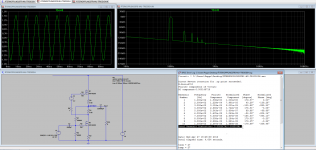
Here is an example what can be done with one of these low voltage high current switch-fets.
It is a simple common source amplifier without global negative feedback, only local source-degeneration with a 1,0 ohm source resistor.
0.0083% THD at 3 volts (P-P) without global negative feedback.
This is probably an unrealistic simulation abnormality, but I believe it is easy to build a very nice sounding low distortion NFB Zen(ish) amp similar to the ACA with these devices.
Cheers,
Johannes
At 12.3 volts output into an 8 ohm load the distortion has increased to 0.153% THD. Still without global negative feedback.
Cheers,
Johannes
Cheers,
Johannes
I would feel a lot better about the low Voltage devices if I could see the Drain curves plotted on a linear current scale at the currents where they would be operated in a class A amp. The models used might not be accurate at low currents. The operating point might also drift significantly with temperature.
Also, it has been suggested to me that Source degeneration counts as feedback and causes the same higher order distortion products that global feedback does. Haven't seen any experimental data to confirm this.
Also, it has been suggested to me that Source degeneration counts as feedback and causes the same higher order distortion products that global feedback does. Haven't seen any experimental data to confirm this.
The operating point might also drift significantly with temperature.
My IRLB3813 is very stable after about 5 minutes warm up. It does not drift more then a few mV except for the first 5 minutes.
Also, it has been suggested to me that Source degeneration counts as feedback and causes the same higher order distortion products that global feedback does
It is feedback, but I would argue that the problems with negative voltage feedback increases by the cube of the numbers of devices within the feedback loop. Source degeneration is the shortest and most linear type of negative feedback possible. The feedback loop is as local as possible as it is just the active gain device and one resistor. The feedback couples into the source pin which is the most linear input node on a gain device.
could see the Drain curves plotted on a linear current scale at the currents where they would be operated
I wish I had some way to measure the transfer curves of mosfets. I am very curious about how they behave at low voltages and currents too. I am pretty certain they are nowhere near as linear as a true SIT device, but you can easily build a very nice sounding amp with one IRLB3813. I have been listening to a single IRLB3813 in a common source amp without any global negative feedback for about 5 hours today. It does sound marvelous except for the lack of bass due to the lack of inductance in the large coil I use as a drainload (only 32mH).
The IRF3711 and IRFP7430 seems like much more "triodish" or "SITish" mosfets then the IRLB3813.
They are all quite fun devices. With the right operating point the IRLB3813 has a very open, alive and effortless character. I have never got the IRFP150 or IRFP250 to sound this good in any circuit. The IRLB3813 does not sound "lush" "rich" or "warm". There is no traces of the typical character of second harmonic distortion. It is just very effortless and alive, like a good low distortion triode amp.
Cheers,
Johannes
It is feedback, but I would argue that the problems with negative voltage feedback increases by the cube of the numbers of devices within the feedback loop. Source degeneration is the shortest and most linear type of negative feedback possible. The feedback loop is as local as possible as it is just the active gain device and one resistor. The feedback couples into the source pin which is the most linear input node on a gain device.
I wish I had some way to measure the transfer curves of mosfets. I am very curious about how they behave at low voltages and currents too.
The high transconductance certainly will help lower the distortion with Source degeneration. I'll try to purchase some of these devices and run them on a curve tracer. The Tek 576 allows you to dial in the threshold Voltage so you can see just how linear the device is. Example: dial in 4.5V threshold and look at 0.1V steps.
On the ACA the distortion raises above 1KHz. I found that using devices with lower input C, IRF530 and IRF520 reduced this. Compared to the IRFP240 I had to dial the tweeter up a little, but it was smoother sounding.
I'll try to purchase some of these devices and run them on a curve tracer
If you are going to buy some of these I would recomend the IRF3711 or the IRFP7430, since these seem much more "triodish" then IRLB3813. The IRLB3813 was the best device I could buy from a Swedish supplier one and a half year ago. If had not already bought the IRLB3813 I would buy the IRFP7430 because it has a TO-247 package and much nicer curves.
Yesterday I built this from some scrap parts lying on my table (and floor):
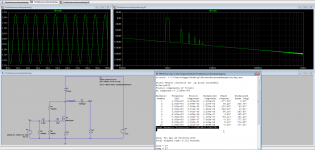
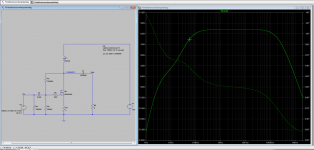
I did not simulate this beforehand. I just took what I had lying around and soldered it together.
Today when I am bit more clear in my head (not as tired as yesterday) I wanted to see how it performs in spice.
The IRFH5300 seems like a good spice substitute for the IRLB3813 since the curves is more similar then to the IRFH6200 ( I don't want to go through the hassle of trying to add a spice model of the IRLB3813 to LTSpice, already tried several times and failed miserably).
It confirms my impression that it is not "lush", "rich" and warm from excessive amounts of second harmonics. It sounds clean and powerful with an effortless liquid presentation of music. It also confirms my impression of a subdued bass. The -3 dB point is at 57 Hz.
I need to add another 200 - 300 turns to my aircored coil or build a MU follower dynamic current source.
Cheers,
Johannes
I found that using devices with lower input C, IRF530 and IRF520 reduced this. Compared to the IRFP240 I had to dial the tweeter up a little, but it was smoother sounding.
I think the only device IR recommends for audio is the IRF530 (and IRF9530). It is a nice a quite linear device. I can imagine it sounds much better then the IRFP240.
I used two paralled IRF9530 in my supersymmetric (Pass SUSY patent) circlotron amp back in 2004. It sounded very very nice.
Cheers,
Johannes
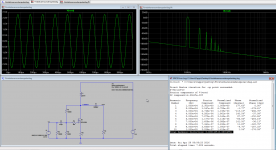
0.683% THD @ 10kHz.
I blame the 300 ohm gatestopper for this. I don't see this as large problem though. I can't even hear the second harmonic of a 10 kHz tone anymore, as I can't hear anything above
about 17 kHz. With a 33 ohm gatestopper resistor the distortion @ 10kHz drops to 0.128% THD.
A brutally high capacitance device like the IRFP7430 will probably sound much better overall if driven from a buffer of some kind (a small Jfet 2SK170 in a sourcefollower) or a powerful preamp.
Cheers,
Johannes
Today I bought a handful of IRLP3034 and IRFP7430.
http://www.irf.com/product-info/datasheets/data/irlp3034pbf.pdf
http://www.irf.com/product-info/datasheets/data/irfp7430pbf.pdf
Exciting and fun curves. I am looking forward to playing with these quite extreme, rugged and powerful devices in simple amplifiers.
I know the big difference in sonic character between an IRFP150 and an IRLB3813 when run at 12 volts Vds and 1.3 ampere in a simple autoformer based source follower amp.
The source-follower layout is not the most revealing way to use a transistor for assessing its character, advantages and flaws. Even so, the difference is staggering with a much cleaner and a much more effortless energetic and dynamic presentation of music with the IRLB3813 part.
Cheers,
Johannes
http://www.irf.com/product-info/datasheets/data/irlp3034pbf.pdf
http://www.irf.com/product-info/datasheets/data/irfp7430pbf.pdf
Exciting and fun curves. I am looking forward to playing with these quite extreme, rugged and powerful devices in simple amplifiers.
I know the big difference in sonic character between an IRFP150 and an IRLB3813 when run at 12 volts Vds and 1.3 ampere in a simple autoformer based source follower amp.
The source-follower layout is not the most revealing way to use a transistor for assessing its character, advantages and flaws. Even so, the difference is staggering with a much cleaner and a much more effortless energetic and dynamic presentation of music with the IRLB3813 part.
Cheers,
Johannes
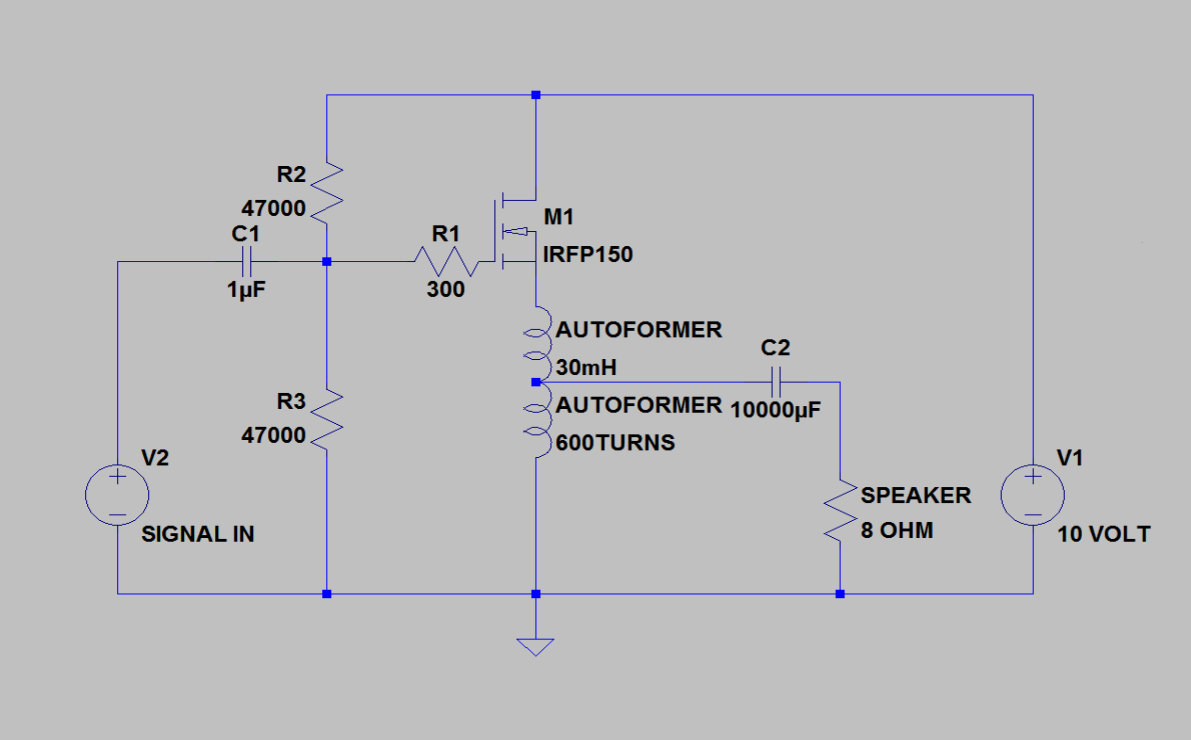
While waiting for the low voltage devices I mentioned in the previous post I wanted to test a Cree SiC mosfet in this simple autoformer coupled source-follower amp. I am running it with 28 volt total and 26.5 volts Vds on the Cree SiC device. I first set the quiescent current to 1.0 ampere.
The results is as interesting as they are disappointing.
The general sound is very open, clear and detailed. I really like it a lot except for the total lack of bass. The bass is absolutely anemic. It sounds as if I am using a 47 uF output capacitor instead of the 10000 uF electrolytic capacitor I am currently using.
If I turn up the current to 3 ampere there is suddenly a slight hint of bass. It might be comparable to using a 220 uF output capacitor, which is better then only 47 uF but still far from good.
I first though I made some error somewhere so I have been tracing every cable,every component and every voltage in the amp and I can't find anything wrong. This does not mean there is no mistake, only that I have tried to eliminate everything I can think of.
Strange.
The IRLB3813 is like a turbo-charged Caterpillar V12 diesel compared to this Cree table-fan electric motor.
I consider the Cree superior a higher frequencies compared to the IR part. There is really no comparison there. I guess it will "wake up" if run with a 100 volts drain-source, but then I need 4:1 step down autoformer or transformer.
Cheers,
Johannes
...except for the total lack of bass...
Another user reported a similar experience using the C3M0065090D in an Aleph circuit. It is an odd phenomenon...
I have seen some comment about this lack of bass with the Cree C3M0065090D..
It is strange. I don't understand why they behave this way.
Except for the lack of bass it sounds very very nice. My 11 year old son commented spontaneously when he heard the Cree SiC fet in my simple source follower "there is no bass but other then that it sounds much better then before" (but he said it in Swedish).
As a fun experiment I changed back to the IRLB3813. I kept everything the same except for the voltage from the powersupply, then I adjusted for the difference in gate to source voltage needed for 1300 mA.
The bass was back with power to spare. All of a sudden it sounded very vivid, alive, very large and there was a great space between all the instruments in the music. The Cree SiC has much more sweet and smooth midrange and treble, but sounds quite held back and cautious compared to the IRLB3813.
Then I changed the IRLB3813 to an old IRF3706 I had lying around.
http://www.irf.com/product-info/datasheets/data/irf3706pbf.pdf
It is a 20 volt TO-220 device, intended for SMPS use (synchronous rectification etc).
It does not sound very similar to the IRLB3813 at all, which surprised me. It does not have as distinct SIT-ish curves as the IRLB3813. I did not think this small difference between the curves and the gate-capacitance would make such a large difference in sound character. Both devices are low voltage high current, high transconductance switchfets that no sane person would buy specifically for linear analogue audio amplification use.
I like it a lot. It does sound very nice. It is not as brutal and exciting as the IRLB3813. Much smoother and correct. Much better treble. It sounds much more similar to a IRFP150 that I used previously in this same amp. My initial impression after an hour listening is that is better then a IRFP150, but I still long for the vivid and lifelike character of the IRLB3813.
Cheers,
Johannes
It is strange. I don't understand why they behave this way.
Except for the lack of bass it sounds very very nice. My 11 year old son commented spontaneously when he heard the Cree SiC fet in my simple source follower "there is no bass but other then that it sounds much better then before" (but he said it in Swedish).
As a fun experiment I changed back to the IRLB3813. I kept everything the same except for the voltage from the powersupply, then I adjusted for the difference in gate to source voltage needed for 1300 mA.
The bass was back with power to spare. All of a sudden it sounded very vivid, alive, very large and there was a great space between all the instruments in the music. The Cree SiC has much more sweet and smooth midrange and treble, but sounds quite held back and cautious compared to the IRLB3813.
Then I changed the IRLB3813 to an old IRF3706 I had lying around.
http://www.irf.com/product-info/datasheets/data/irf3706pbf.pdf
It is a 20 volt TO-220 device, intended for SMPS use (synchronous rectification etc).
It does not sound very similar to the IRLB3813 at all, which surprised me. It does not have as distinct SIT-ish curves as the IRLB3813. I did not think this small difference between the curves and the gate-capacitance would make such a large difference in sound character. Both devices are low voltage high current, high transconductance switchfets that no sane person would buy specifically for linear analogue audio amplification use.
I like it a lot. It does sound very nice. It is not as brutal and exciting as the IRLB3813. Much smoother and correct. Much better treble. It sounds much more similar to a IRFP150 that I used previously in this same amp. My initial impression after an hour listening is that is better then a IRFP150, but I still long for the vivid and lifelike character of the IRLB3813.
Cheers,
Johannes
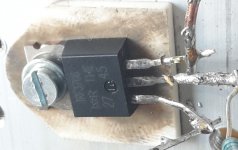
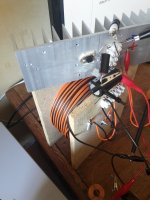
My f(r)iend Anders Martinsson with whom I developed the THAM series of tapped horns some years ago is teasing me for only building single channel mono amplifiers with a less then spectacular layout and build discipline....
He speaks about something called "stereo" where you are supposed to use two reasonable similar channels to drive two reasonably similar loudspeakers....
I don't know.... I like the fire hazard with bare live electric cables and alligator-leads all over the place.
😉
Cheers,
Johannes
- Status
- Not open for further replies.
- Home
- Amplifiers
- Pass Labs
- Why IRLB3813 and similar (strange) low voltage devices?!